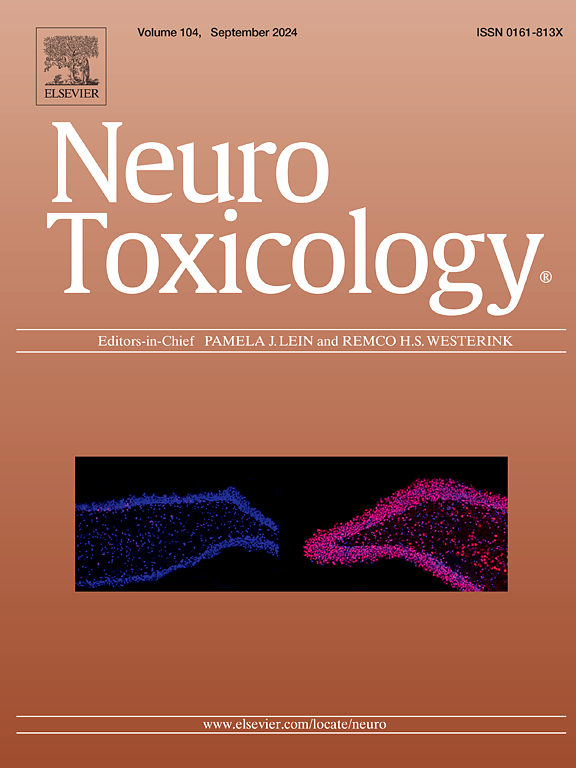Role of dopaminergic RE1-silencing transcription factor (REST) in manganese-induced behavioral deficits and dysregulating dopaminergic and serotonergic neurotransmission in mice
IF 3.9
3区 医学
Q2 NEUROSCIENCES
引用次数: 0
Abstract
Chronic exposure to elevated levels of manganese (Mn) induces manganism, a neurological disorder, exhibiting symptoms resembling Parkinson’s disease (PD). Mn is well known to dysregulate dopaminergic (DAergic) function, while the repressor element-1 silencing transcription factor (REST) induces protection against Mn-induced toxicity and several neurodegenerative diseases, including PD and Alzheimer’s disease. In the present study, we investigated if DAergic REST plays a role in Mn-induced neurotoxicity by assessing behavioral deficits and alteration of neurotransmitter levels using high-performance liquid chromatography with electrochemical detector (HPLC-ECD), and microdialysis between DAergic-specific REST-deleted (REST cKO) mice and REST loxP mice as wild-type (WT) controls. Mice were exposed to Mn (330 μg, daily intranasal instillation for 3 weeks), followed by assessment of locomotor activity and novel object recognition, and subsequent brain dissection. Neurotransmitters, including DA, serotonin (5-HT), norepinephrine (NE), and glutamate, were analyzed in different brain regions, such as the striatum, midbrain, cortex, hippocampus, and cerebellum. After Mn exposure, extracellular DA levels in the striatum were measured by HPLC-microdialysis. The results showed that DAergic REST deletion exacerbated Mn-induced behavioral deficits and decreased DA levels in the nigrostriatal regions of WT mice. REST cKO increased DA turnover rates (DOPAC/DA and HVA/DA) by 10-fold in the nigrostriatal regions, showing lesser effects in other brain regions. Mn decreased extracellular DA levels, as measured by microdialysis, in the striatum in both genotypes. Mn decreased cortical NE levels in both genotypes and further exacerbated in REST cKO, while Mn decreased nigrostriatal NE levels only in REST cKO mice. REST cKO reduced 5-HT levels in all brain regions tested compared to WT mice. Mn increased glutamate and GABA levels in the striatum and midbrain, while these Mn effects were not altered by REST cKO. Taken together, our findings demonstrate that DAergic REST deficiency exacerbates Mn-induced motor and cognitive deficits along with dysregulation of neurotransmitters, mainly DA, 5-HT, and NE, suggesting that DAergic REST is important in Mn-induced dysregulation of monoaminergic neurotransmission.
多巴胺能RE1抑制转录因子(REST)在锰诱导的小鼠行为缺陷以及多巴胺能和血清素能神经传递失调中的作用
长期暴露于高水平的锰(Mn)会诱发锰中毒,这是一种神经系统疾病,表现出类似帕金森病(PD)的症状。众所周知,锰可以失调多巴胺能(DAergic)功能,而抑制因子-1沉默转录因子(REST)可诱导对锰诱导的毒性和多种神经退行性疾病的保护,包括PD和阿尔茨海默病。在本研究中,我们使用高效液相色谱电化学检测器(HPLC-ECD)评估DAergic特异性REST缺失(REST cKO)小鼠和REST loxP小鼠作为野生型(WT)对照,通过微透析评估行为缺陷和神经递质水平的改变,研究DAergic REST是否在mn诱导的神经毒性中发挥作用。小鼠暴露于Mn (330 μg,每日鼻内滴注,持续3周),随后评估运动活动和新物体识别,随后进行脑解剖。在纹状体、中脑、皮质、海马和小脑等不同脑区分析神经递质,包括DA、血清素(5-HT)、去甲肾上腺素(NE)和谷氨酸。暴露于锰后,用高效液相色谱-微透析法测定纹状体细胞外DA水平。结果表明,DAergic REST缺失加重了mn诱导的WT小鼠的行为缺陷,降低了黑质纹状体区域的DA水平。REST cKO在黑质纹状体区域显著提高了10倍以上的DA周转率(DOPAC/DA和HVA/DA),对其他脑区影响较小。在两种基因型中,Mn均降低纹状体突触DA水平。Mn降低了两种基因型小鼠的皮质NE水平,并在REST cKO小鼠中进一步加剧,而Mn仅在REST cKO小鼠中降低了黑质纹状体NE水平。REST cKO降低了所有测试脑区的5-羟色胺水平。Mn增加纹状体和中脑谷氨酸和GABA水平,而这些Mn的作用未被REST cKO改变。综上所述,我们的研究结果表明,DAergic REST缺乏加剧了mn诱导的运动和认知缺陷以及神经递质(主要是DA、5-HT和NE)的失调,这表明DAergic REST在mn诱导的单胺能神经传递失调中很重要。
本文章由计算机程序翻译,如有差异,请以英文原文为准。
求助全文
约1分钟内获得全文
求助全文
来源期刊

Neurotoxicology
医学-毒理学
CiteScore
6.80
自引率
5.90%
发文量
161
审稿时长
70 days
期刊介绍:
NeuroToxicology specializes in publishing the best peer-reviewed original research papers dealing with the effects of toxic substances on the nervous system of humans and experimental animals of all ages. The Journal emphasizes papers dealing with the neurotoxic effects of environmentally significant chemical hazards, manufactured drugs and naturally occurring compounds.
 求助内容:
求助内容: 应助结果提醒方式:
应助结果提醒方式:


